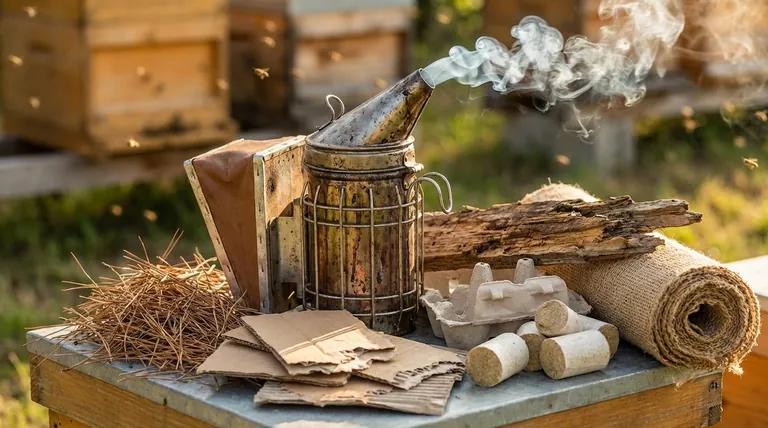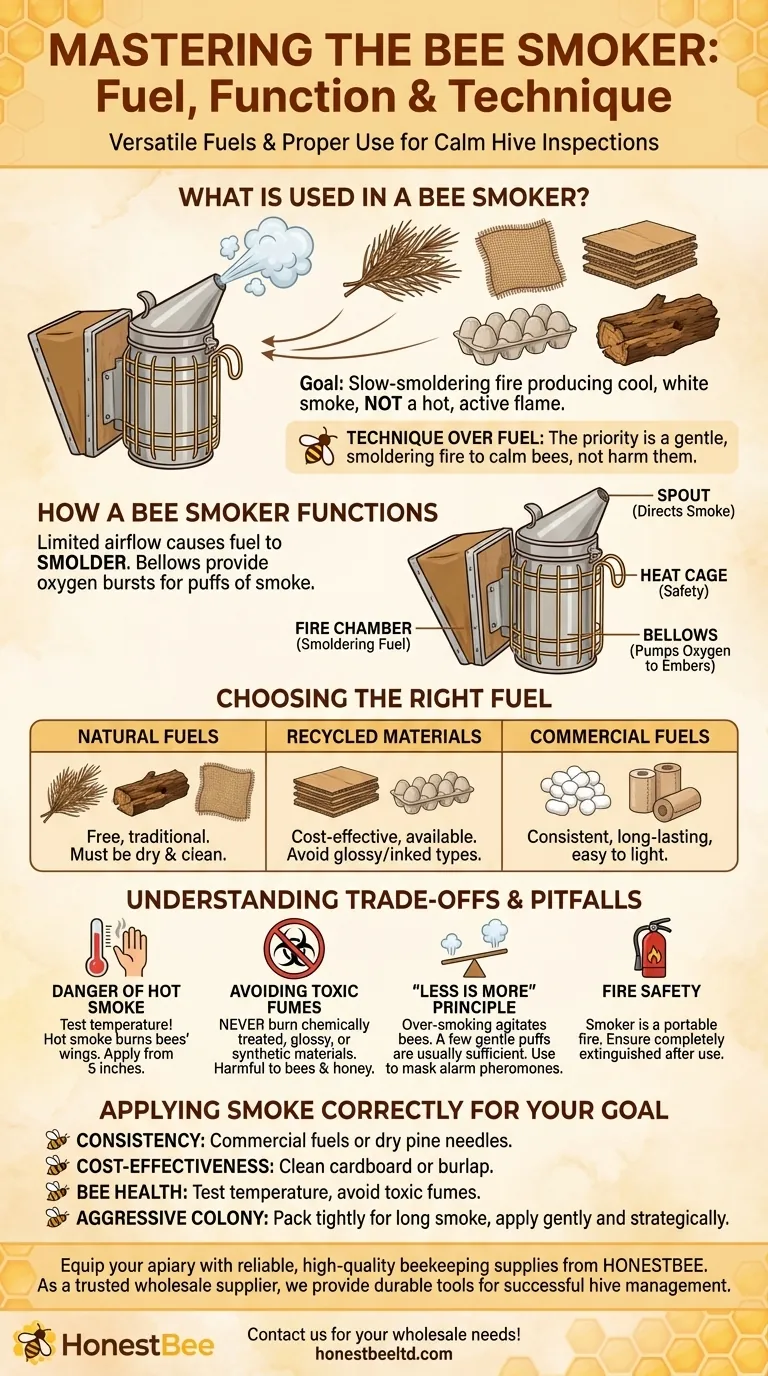The fuel for a bee smoker is incredibly versatile, ranging from natural materials found in your yard to commercially produced products. Beekeepers commonly use dry materials like pine needles, burlap fabric, corrugated cardboard, paper egg cartons, and even rotten wood. The primary goal is to select a fuel that smolders slowly and produces a large volume of cool, white smoke, not a hot, active flame.
The specific fuel you choose is less critical than the technique you use. A successful beekeeper's goal is to create a slow-burning, smoldering fire that produces cool, gentle smoke to calm bees, not to create a hot or aggressive fire that could harm the colony.

How a Bee Smoker Functions
To use smoker fuel effectively, you must first understand the tool itself. The bee smoker is a simple yet ingenious device designed for a single purpose: controlled smoke production.
The Core Components
A smoker consists of three main parts. The fire chamber is a metal canister, often with an inner grid or cup, that holds the burning fuel.
Attached to this is a set of bellows, which are squeezed to pump oxygen into the base of the fire chamber. This burst of air is what generates the puffs of smoke.
Finally, a conical lid narrows to a spout or nozzle, which directs the smoke precisely where you need it. Many smokers also include a wire heat cage for safety and a hook for hanging the tool on the hive.
The Principle of Smoldering
The smoker is not designed to maintain a roaring fire. The fire chamber is mostly enclosed, limiting airflow and causing the fuel to smolder rather than burn with an open flame.
Squeezing the bellows provides just enough oxygen to revive the embers and produce a thick puff of smoke. This slow-burning process allows the fuel to last for the duration of a hive inspection.
Choosing the Right Fuel
While many materials can work, they fall into a few distinct categories. The best choice often depends on availability, cost, and personal preference.
Natural and Readily Available Fuels
Materials like dry pine needles, rotten wood, and hessian fabric (burlap) are traditional favorites. They are often free and highly effective.
Ensure these materials are completely dry and free from mold or contaminants to produce clean smoke.
Recycled and Household Materials
Clean corrugated cardboard (with tape and labels removed) and paper egg cartons are excellent, readily available options.
These materials are easy to ignite and produce good smoke. Always ensure they are free from plastic coatings, gloss, or excessive inks.
Commercial Smoker Fuels
Many beekeeping suppliers sell fuel made from compressed cotton or pulped paper. These are often sold as pellets or rolls.
The main advantage of commercial fuels is their consistency. They are formulated to light easily, smolder for a long time, and produce reliable smoke.
Understanding the Trade-offs and Pitfalls
Using a smoker correctly is as important as choosing the right fuel. Mishandling it can be ineffective at best and harmful at worst.
The Danger of Hot Smoke
The smoke must be cool. Before puffing smoke onto bees, test the temperature on the back of your hand. If it feels hot, let the smoker cool down.
Always apply smoke from a distance of at least five inches. Hot smoke or embers can easily burn the bees' delicate wings.
Avoiding Toxic Fumes
The health of your colony is paramount. Never burn materials treated with chemicals, such as pressure-treated wood, glossy paper, plastic, or synthetic fabrics.
These materials can release toxic fumes that will harm or kill your bees and can potentially contaminate the honey. Stick to clean, natural, and untreated fuel sources.
The "Less Is More" Principle
Over-smoking a hive can cause the bees to become agitated or abscond. A few gentle puffs at the entrance before opening the hive, and another few across the top frames, is usually sufficient.
Only use more smoke if the colony is particularly aggressive. If you get stung, puffing a little smoke on the sting site can help mask the alarm pheromone and prevent other bees from attacking the same spot.
Fire Safety is Non-Negotiable
A bee smoker is a portable fire. Handle it with extreme care, as the fire chamber becomes incredibly hot.
When you are finished, ensure the fire is completely extinguished. You can do this by stuffing the spout with green grass to choke the embers or by safely emptying the contents onto a non-flammable surface like concrete or dirt.
Applying Smoke Correctly for Your Goal
Your approach to using a smoker should be calm, deliberate, and strategic. Your choice of fuel and technique can be adapted to your specific situation.
- If your primary focus is consistency: Start with commercial fuels or clean, dry pine needles, as they provide a reliable, long-lasting smolder.
- If your primary focus is cost-effectiveness: Use readily available materials like clean corrugated cardboard or burlap, ensuring they are free of contaminants.
- If your primary focus is bee health: Always test the smoke's temperature before use and strictly avoid any fuel that could release toxic fumes.
- If you are dealing with an aggressive colony: Pack your smoker tightly for long-lasting smoke, but remember to apply it gently and strategically, adding extra puffs only as needed.
Mastering the smoker is a fundamental step toward becoming a calm and confident beekeeper.
Summary Table:
| Fuel Type | Examples | Key Characteristics |
|---|---|---|
| Natural Fuels | Pine needles, rotten wood, burlap | Free, traditional, must be dry and clean |
| Recycled Materials | Corrugated cardboard, paper egg cartons | Cost-effective, readily available, avoid glossy/inked types |
| Commercial Fuels | Compressed cotton/pulp pellets or rolls | Consistent, long-lasting, easy to light |
Equip your apiary with reliable, high-quality beekeeping supplies from HONESTBEE.
As a trusted wholesale supplier for commercial apiaries and equipment distributors, we provide the durable tools you need for successful hive management. From smokers and fuel to protective gear and hive components, our products are built for the demands of professional beekeeping.
Let's discuss your supply needs. Contact our team today to learn more about our wholesale offerings and how we can support your operation's growth and efficiency.
Visual Guide

Related Products
- 54-Piece Smoker Fuel Pellets for Beekeeping Beehive Smoker Fuel
- Stainless Steel Honey Bee Smoker Hive and Honeycomb Smoker for Beekeeping
- Premium Traditional Copper Bee Smoker with Bellows
- Miniature Stainless Steel Bee Smoker for Beekeeping
- Electric Bee Smoker European Style Bee Hive Smoker for Beekeeping
People Also Ask
- What is best to burn in a bee smoker? Master the Layered Fuel Technique for Calm Hives
- What to put in a bee hive smoker? A Guide to Natural, Calming Fuels
- How should you start the fire in a bee smoker? A Step-by-Step Guide for a Calm Hive
- What is the best bee hive smoker fuel? Choose Natural, Slow-Burning Fuel for Calm Bees
- What is the best material for a bee smoker? Choose the Right Fuel for a Calm Hive



















